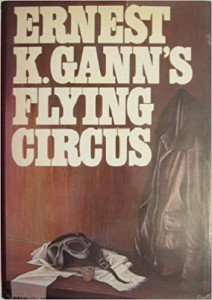217th Review Ernest K. Gann’s Flying Circus- Ernest Kellogg Gann
In 1935 Ernest K. Gann began barnstorming. Like so many other pilots in the early days of aviation, Gann’s passion for flying started with wood and canvass bi-planes. He would eventually become an airline pilot, flying many types of airplanes in different parts of the world.
Gann later became a successful writer of novels and non-fiction. He published over 24 books. His novels The High and the Mighty (1935), Islands in the Sky (1944) and Fate is the Hunter (1961) became very well received films. Fate is the Hunter is Gann’s memoir of flying as an airline pilot from the 1930s to the 1950s.
Ernest K. Gann’s Flying Circus is the epitome of enthusiasm for flying. Today, the book serves to assuage nostalgia for the early days of aviation. The book borrows part of its title from Eddie Rickenbacker’s 1919 WWI memoir, Fighting The Flying Circus. Rickenbacker was an American Ace, with 26 aerial victories. The Flying Circus was the German fighter wing (Jagdgeschwader 1) that was commanded by Manfred von Richthofen during WWI, the ace who was later nicknamed the “Red Baron.”
Ernest K. Gann was born on October 13, 1910 and died on December 19, 1991. Mr. Gann, the writer, is as knowledgeable and well-grounded in human events as any worldly man from his generations.
Gann writes about aviation the world over. In a chapter entitled “Saint-Exupéry’s Century,” the subject of the essay is the French writer and aviator, Antoine de Saint-Exupéry, best known for writing The Little Prince. The chapter explores the camaraderie between Saint-Exupéry and his good friend, and fellow pilot Jean Mermoz (1901-1936), in the early days of France’s Compagnie générale aéropostale airmail service.
Consider the following crisp and lyrical example of Gann’s writing as he describes the French pilots who belonged to the Vielles Tiges: “Habitués of the Club Vielles Tiges will discuss almost anything as long as it is aeronautically oriented, and the names they drop so casually are the stuff of French air legends and the principal well from which a certain poet-pilot known as Saint-Exupery drew forth his masterful tales.”
Gann’s stories of flying are graced with a sense of nostalgia, even in 1974, when this fantastic book was first published. Gann laces his writing with literary fervor. His writing is economical, for he goes straight for his objective, which is to relate tales of flying, friendship and the lure of the sky. Gann does not waste words.
The book’s preface sets the pathos for what is to come in subsequent chapters. Gann’s lyrical descriptions and sentiment make his tales about time, place and machines, lively, and always offering a noble perspective on human life. With a poetic pen, he describes the sensation of flight and man’s petty disputes: “Aloft, the earth is ancient and man is young, regardless of his numbers, for there, aloft, he may reaffirm his suspicions that he may not be so very much. This is the gateway to humility.” What pilot has not encountered these same emotions?
In “Notice to Airmen” Gann warns younger generations of flyers and his readers that, while there may be new advances in aviation, the world was not created today – as it were. The author describes the passage of time, culture and technology in the following manner – “There have been other days, much simpler, more immoderate and infinitely more joyful for those whose very life and love was flight.”
Gann describes the days when airports were few and polished runways were scarce. He informs the reader that control towers didn’t began to appear until the mid-1930s. Flying was mostly done through the seat-of-the-pants. He assures us that “Navigation was almost entirely avigation,” as most pilots didn’t even know about radio beams.
Gann ends the book with an appendix that he calls “Dossier on Principal Characters,” where he lists the specifications of all 23 airplanes that he writes about in the book. All of the airplanes are interesting, if not historically important. He cites that the Douglas DC-4 had a rare stall-speed characteristic: “Stall speeds were better (lower) with power off than with power on – loads being equal.” Equally interesting, the Boeing 377 Stratocruiser’s “pressurized cabin equals 5,500 feet at 25, 000 feet.”
Ernest Gann’s Flying Circus will excite aviation enthusiasts for as long as there are people interested in flying and aviation history. There is much to appreciate about this marvelous book. It is written by a master pilot who began flying in the heyday of commercial aviation; an aviator who witnessed tremendous developments in aviation, and one who is a well-rounded and gifted writer.











Leave a Reply